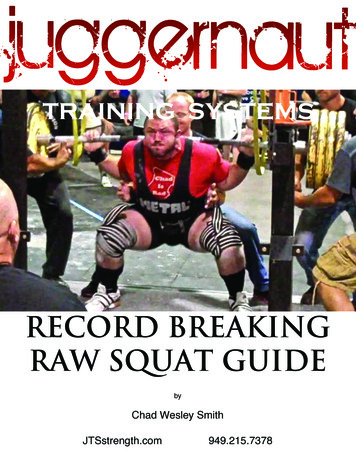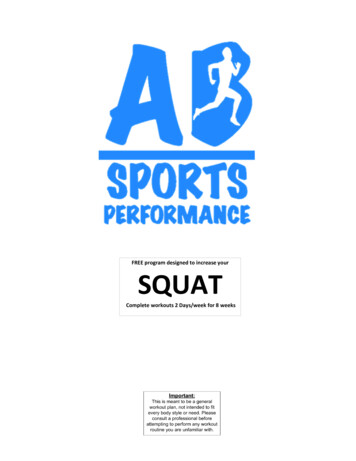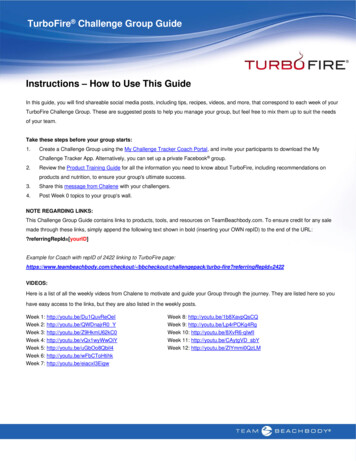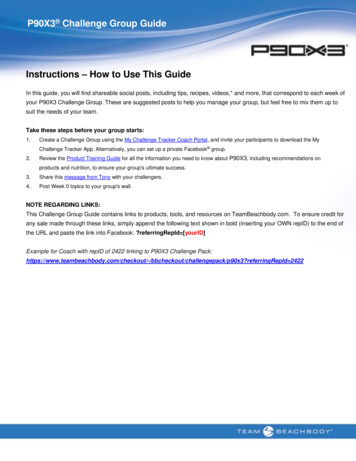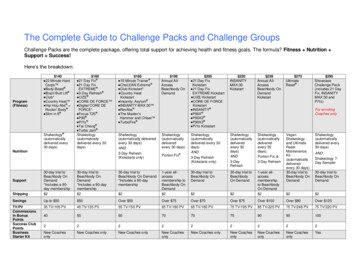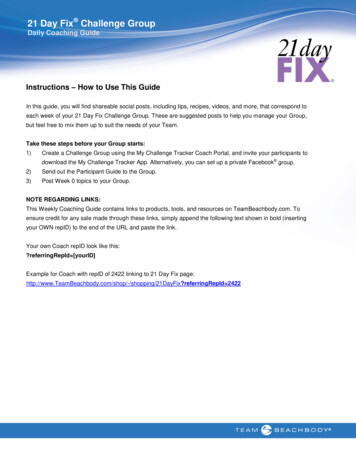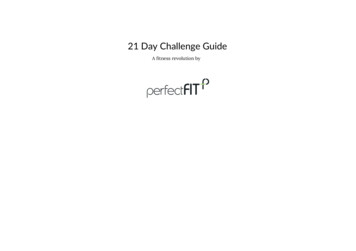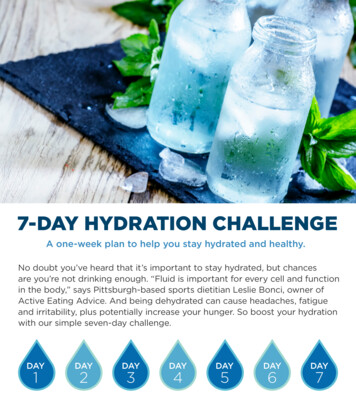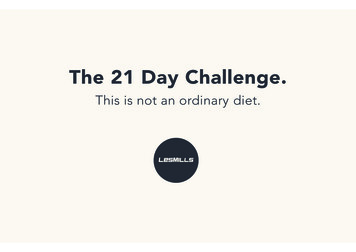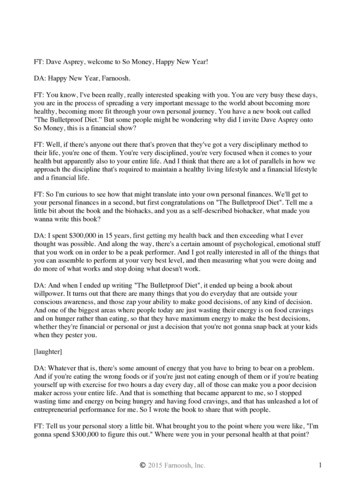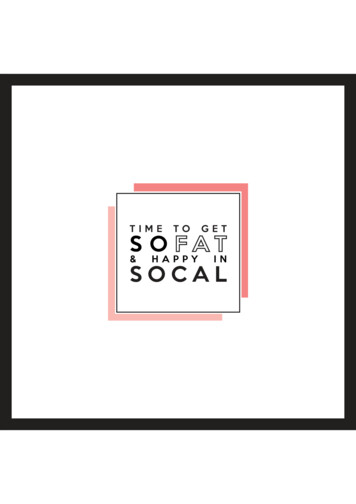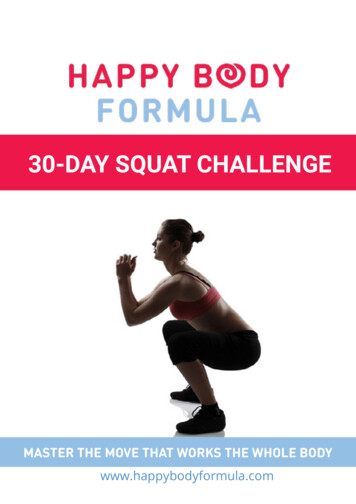
Transcription
30-DAY SQUAT CHALLENGEMASTER THE MOVE THAT WORKS THE WHOLE BODYwww.happybodyformula.com
ONE EXERCISE TO MASTER FOR THE REST OF YOUR LIFEIf you ask what exercise you should master for the rest of your life, we’re gonnasay it’s the squat. It’s a full-body exercise, and it addresses far more musclesthan the glutes, which is what the squat is known for. It’s a dynamic and powerful movement that almost anyone can do, if modified properly. You can build onit, too, so there is always room to progress.We’re covering the benefits of squats, the basics of how to do them properlyand we’re giving YOU a challenge. Are you up for it?Why the squat benefits the entire bodyThe squat might seem like a booty-centric exercise, and it totally is. Truly,though, it works pretty much every muscle in the body. A properly executedsquat will actually release hormones – the human growth hormone and testosterone, to be precise – which help our bodies to build muscle. In essence,squatting can help us to build muscle as we do other exercises. It’s pretty cool,and that’s part of the reason why we think this is the exercise you should master above the rest. Glutes. Your bum is one of the two primary muscle groups that the squatworks. When you come up from a proper squat, the glutes should be tightand engaged, like you’re squeezing them together. You will feel it the nextday! Quads. This is the other primary group of muscles you’ll engage. You want topower up your squat by making sure your quads are doing much of the work.www.happybodyformula.com2
The squat also begs you to keep your core tight and your back/shouldersstraight. While this is mostly important for proper form and avoiding injury,it can help strengthen your core. Squats also improve mobility in the ankles,knees and hips. If you practice the squat enough, you’ll begin to understandwhere your weakness lies! Hitting depth is more a matter of mobility than itis strength, so increasing flexibility and range of motion are a huge benefit ofmany exercises. It’s a great anti-ageing exercise too, as squatting is a movementthat we perform in our daily life, and you want to be able to do it without achesand pains well into your 90s.This image shows the muscle groups most used when you squat. If you addsome weights, then you can also include a few more upper body muscle groups.The basics of the squatLet’s take things step by step. The squat is only effective if you do it right, sodon’t neglect mastering the art! Form is incredibly important, and centralisingthe movement to activate the proper muscle groups is a fantastic way to affirmyou’re doing it correctly. In other words, you should feel the burn. Begin in a standing position with your feet around the same width as yourshoulders. Move the hips back and bend the knees at the same time to descend intosquat position. Keep your back straight, knees and feet facing forward and heels on theground. Keep your arms out straight, and your chest and face forward.www.happybodyformula.com3
Your knees should not go over your toes at the bottom but rather be inline with your toes. Imagine drawing a vertical line from your knee to yourthird or fourth toe. It should be a straight line. If your knees go too far forward over the toes, bring them back in line; if they rotate inwards, make sureto open them up so they are in line with your feet and toes. Ensure you’rekeeping your back straight in position and your spine long, don’t collapseforward too much. Return to the standing position, using your quads to power up and squeezing the glutes as you get back to the standing position.There are two ways to squat – parallel and below parallel. In the illustrationabove, you see a squat at parallel which means you’re bending at around a90-degree angle at the hips. A squat at below parallel (see below) – otherwiseknown as “ass to grass” – means your bum will touch the back of your calves.Neither of these is right nor wrong. Your ideal squat will depend on whetheror not you’re bearing weight, the weight you are bearing, your mobility and/oryour level of fitness overall.www.happybodyformula.com4
You’ll know when your squat is wrongSome common mistakes can easily be identified by pain. Overall, your squatshould not feel painful. Take notice if you feel strain in your ankles, knees orhips i.e. the places you’re going to be hinging and adding stress to. Your kneesshould point outwards (like your toes are) and not cave in nor flop out. Yourankles should also remain tight and stable, as you’re relying on their balance tokeep you down and pull you back up.Your hips might feel tight and sore, which is why stretching, foam rolling andrest days are important. In this case, you can move your feet out a little further in starting position, which tends to take some of the pressure from thehips during the exercise.Another mistake that can make your squat ineffective and feel far less pleasantis leaning too far forward in squat position, descending too quickly (especially when bearing weight), releasing tension in the core during the exercise orstraining your back. Squatting with weight is an easy way to back injury inparticular, because a heavy bar on your shoulders makes you want to arch yourback inwards. Avoid this at all costs – even during body weight squats.All in all, your entire body should be engaged, tight and straight. You don’twant your position to change at all during the exercise.www.happybodyformula.com5
VARIATIONS OF THE SQUATLow and slow squatsThis is that below parallel squat we’retalking about. Rushing your descent orascent can be outright dangerous, so ifyou really want to practise form and geta good burn, this is IT. You want to reachdepth while keeping your back straightand knees from walking. Take it easy,which will really encourage your musclesto engage.Pulse and pause squatsAt the bottom of a squat, pull the glutes up to pulse the primary engaged muscles, including the quads. Pause at the bottom focusing on serious stability, andreturn to the starting position.Against the wall squatsIf you’re feeling tight in the hips or like your formis lacking, this is a brutal variation that will helpyou to master your form as well as get in a goodworkout. Stand with your back pressed against thewall, and your feet about three feet away from it.Your goal will be for your knees not to bend pastyour toes, so adjust form accordingly. Continue insquat position until your thighs reach horizontal,so hips will be around at a 90-degree angle.Wide-stance plie or sumo squatThis one is fantastic for the inner thighs which is a pretty popular “problemarea.” This squat simply assumes a different, wider stance starting position. Thefeet will be wider than the shoulders, which we mentioned above can be greatfor those who experience limited mobility at their hinge too! Simply come down,keeping the same standard and safe squat form, and pull back up. You’ll feelmore engagement in your inner thighs in this position than you do your quads.See how-to image on the next page.www.happybodyformula.com6
Jump squatsThis is simply a squat, except every time you return to starting position, you’lljump at the top. A helpful tip is to reach your arms up as you jump to keeprhythm and balance in-tact. This is tough, but it’s a great addition to high-intensity interval training. Image below is from Burnit.com.www.happybodyformula.com7
Narrow squatUnlike the plie squat, the narrow squatasks you to take your feet in much moreclosely to one another. Place your feetside by side and assume squat position.It won’t feel so natural, so pay attentionto your form, making sure it isn’t differing. It can be a challenge to hit depth onthis one while making sure your bodystays tight and forward-facing.The pistol squat/ single leg squatThis is the one-legged squat, and it’s tough stuff! You’ll want to maintain thesame exact form, but you’ll only use one leg. As you move into the squat position from starting position, you’ll lift your leg up from the floor. At the bottomof your squat, your leg will stick straight out. This is the squat in the photo below. You will also want to use your arms to keep your balance. The beginner’sversion of this exercise could include a bench to rest your bum on when youhit depth. It can also be easier with a weight – such as a kettlebell – in one arm.Learn more how to do a single leg squat here.www.happybodyformula.com8
ADDING WEIGHT TO YOUR SQUATThere are many ways you can increase the intensity of your squat by addingweight. Whether you have access to a full gym or you’re more of a workout-athome kind of person, adding weight can be great for adding muscle, toning upand just challenging yourself overall.The barbell back squatThis is the variation pictured above. Generally, you’ll be in a rack which providessome safety measures (i.e. bars to rest the weight if you fail your squat). Youwant to place the bar on your back. No matter how much weight is racked oneither side, this should not hurt; it should rest in between your shoulder bladescomfortably. Then, you want to bend at the elbows and hold the bar from behind. The width of your arms will vary, but don’t hold them too wide. Finally, youwill resume your squat with even more of an emphasis on form. You shouldalways begin this exercise by warming up with just the bar, gradually addingweight up to your working rep weight. Image from MyProtein.comwww.happybodyformula.com9
Kettlebell squatsKettlebells are an amazing tool, and you can easily (and affordably) add one ortwo to your home gym – even if you’re strapped for space. The kettlebell offers afew weighted squat options. First, you could practise goblet squats. You will rackyour kettlebell up with one arm, and hold it with both, elbows bent, in the centreof your chest. Then, you will squat as usual. This can actually be super helpfulin hitting depth, as it’s both centred and weighing you down. Alternatively, youcan rack two kettlebells from the floor in either arm, and do a double kettlebellsquat. Ouch! It burns. So good. Read more about our favourite kettlebell workouts. Image from Oxygenmag.com.Dumbbell squatsThese work in much the same way askettlebells. You can do goblets or doublekettlebell squats in much the same way.With a dumbbell, you’ll want to hold itin the middle. The purpose is the same,roughly – to balance, centre and weighyou down. For a double squat, you wantto hold the bells in the middle rightabove your shoulders.Image from Stack.com.www.happybodyformula.com10
TAKE ON THE 30-DAY SQUAT CHALLENGE!And now for the challenge! You could devise something based on the above,starting out with just basic squats and increasing the repetition each day; thenmoving into including some variations and then advancing to adding someweights as well. You can always add weight to the body weight squats if youhave access to it, or if you are working at a gym with a barbell. For the sake ofaccessibility, there will be no barbell-specific workouts in our challenge.You can choose to do your workout all at once, add in the squats on top of yourcurrent routine or just aim to meet your quota throughout the day. Commercialbreak squat intervals are a totally valid way of getting in those reps! Break itdown and modify the challenge into manageable chunks for your fitness leveland time restraints.If you’re doing each day’s exercises in one go, feel free to break them downinto sets and allow a short rest in between moves.Before doing a full set of daily squats, it’s a good idea to warm up by doinga minute of start jumps on running on the spot. Stretching at the end of thesession or at the end of the day will help to prevent muscle soreness and recovery. Below are some basic stretches for the muscle groups worked during asquat.www.happybodyformula.com11
30-DAY SQUAT CHALLENGEDAY 1DAY 230 basic body weight squats25 basic body weight squats 10low and slow squatsSets of 3 x 10 with 1 minute restsin between.Sets of 2 x 10/15 10 with 1 minuterests in between.DAY 3DAY 430 basic body weight squats 10pulse and pause squats 5 lowand slow squats30 basic body weight squats 10 jump squats 10 wide-stanceplie/sumo squatsSets of 2 x 15 10 5 with 1 minuterests.Sets of 2 x 15 10 10 with 1 minute rests.DAY 5DAY 6REST DAY / STRETCH35 body weight squats 20 widestance plie/sumo squats 5 lowand slow squatsSets of 2 x 18/17 20 5 with 1 minute rests.DAY 7DAY 840 body weight squats 20 narrow squats 5 jump squats50 body weight squats 15 low andslow squatsSets of 2 x 20 20 5 with 1 minute rests.Sets of 2 x 25 15 with 1 minute rests.Add weight to 1 set, if possible.DAY 9DAY 1050 body weight squats 20 widestance plie/sumo squatsREST DAY / STRETCHSets of 2 x 25 20 with 1 minuterests. Add weight to 1 set, if possible.www.happybodyformula.com12
30-DAY SQUAT CHALLENGEDAY 11DAY 1250 body weight squats 25 narrow-stance squats60 body weight squats 20 jumpsquats 5 low and slow squatsSets of 2 x 25 2 x 12/13 with rests.Add weight to 2 sets, if possible.Sets of 3 x 20 2 x 10 5 with rests.DAY 13DAY 14Sets of 3 x 20/25 20 10 withrests. Add weights to plie squats.Sets of 2 x 35 2 x 10 5 with rests.DAY 15DAY 16REST DAY / STRETCH75 body weight squats 25 lowand slow squats65 body weight squats 20 pulseand pause squats 10 widestance plie/sume squats70 body weight squats 20against-the-wall squats (pause for5 seconds) 5 low and slow squatsSets of 2 x 37 2 x 12/13 with rests.Add weight to 2 sets, if possible.DAY 17DAY 1880 body weight squats 30 jumpsquats80 body weight squats 35 widestance plie/sumo squatsSets of 4 x 20 3 x 10 with rests.Sets of 4 x 20 2 x 17/18 with rests.Add weight to 2 sets, if possible.DAY 19DAY 2085 body weight squats 35 pauseand pulse squatsREST DAY / STRETCHSets of 4 x 22/23 2 x 17/18 withrests. Add weights to 1 set of each, ifpossible.www.happybodyformula.com13
30-DAY SQUAT CHALLENGEDAY 21
workout. Stand with your back pressed against the wall, and your feet about three feet away from it. Your goal will be for your knees not to bend past your toes, so adjust form accordingly. Continue in squat position until your thighs reach horizontal, so hips will be around at a 90-degree angle. Wide-stance plie or sumo squat This one is fantastic for the inner thighs which is a pretty .File Size: 495KBPage Count: 14
